Mesa Verde NP
Useful Information
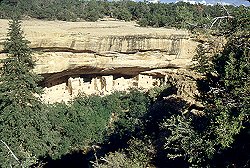
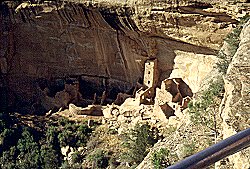
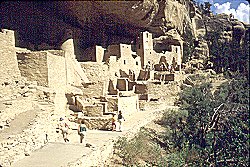
| Location: |
34879 Highway 160, Mancos, CO 81328.
Midway between Cortez and Mancos, off U.S. 160. I70, exit at Grand Junction, Hwy 6, then Hwy 50 south, from Montrose Hwy 550 south to Durango, west on Hwy 160. I70, exit at Crescent Junction, south on Hwy 191 to Monticello, southeast on Highway 666 to Cortez, east on Hwy 160. I25, exit Walsenburg, west on Hwy 160 through Alamosa, Monte Vista, Durango. (37.3358818, -108.4077904) |
| Open: |
Park:
All year daily 8 to sunset.
Visitor & Research Center: All year daily 8:30-16. Closed 01-JAN, Thanksgiving, 25-DEC. Mesa Verde Museum: JAN to 04-MAY daily 10-15. 05-MAY to 19-OCT daily 8:30-16:30. 20-OCT to DEC daily 10-15. Closed 01-JAN, Thanksgiving, 25-DEC. [2025] |
| Fee: |
Park:
Car USD 30, Motorcycle USD 25, Adults USD 15. Ranger-Guided Tours: Adults USD 8, Children (0-2) USD 1. Square Tower House: Adults USD 25. Self Guided Tours: free. [2025] |
| Classification: |
 Cave Castle, Cave Castle,
 Cave House, Cave House,
 Cliff Dwellings of the U.S. West
sandstone Cliff Dwellings of the U.S. West
sandstone
|
| Light: | none, bring electric torch for buildings |
| Dimension: | |
| Guided tours: | V=600,000/a [2005] |
| Photography: | alloed |
| Accessibility: | partly |
| Bibliography: | Gustaf Nordenskiold (1910): The Cliff Dwellers of the Mesa Verde |
| Address: |
Mesa Verde National Park, P.O. Box 8, Mesa Verde, Colorado 81330, Tel: +1-970-529-4465.
E-mail: |
| As far as we know this information was accurate when it was published (see years in brackets), but may have changed since then. Please check rates and details directly with the companies in question if you need more recent info. |
|
History
| 550 | first traces of settlement. |
| 1200 | start of the construction of cliff dwellings. |
| 1300 | Pueblo people vanish. |
| 1884 | Balcony House first entered by the prospector S. E. Osborn. |
| DEC-1888 | Cliff Palace discovered by ranchers Richard Wetherill and Charlie Mason who searched Mesa Verde’s canyons for stray cattle. |
| 1891 | explored and photographed by Swedish scientist Gustaf Nordenskiold. |
| 29-JUN-1906 | Mesa Verde National Park established by President Theodore Roosevelt. |
| 1910 | Balcony House excavated by Jesse Nusbaum. |
| 1959 | excavation of Long House started, as part of the Wetherill Mesa Archeological Project. |
| 1961 | excavation of Long House ended. |
| 1978 | inscribed on the UNESCO World Heritage List. |
Description
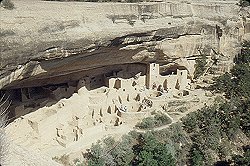
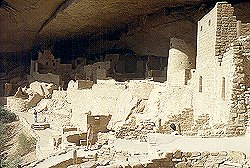



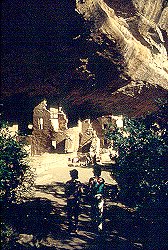
The name Mesa Verde, the Spanish term translates Green Table, describes the landscape pretty well. A high plane, which is green because of frugal shrubs and trees, a so-called pinyon-juniper forest, is divided into huge tablelands by deep valleys, gorges and ravines. The walls of the valleys are sandstone cliffs, often overhanging, forming huge caverns and shelters. The shelters formed in the Cliff House Formation, which is 78 million-year-old Cretacious sandstone of reddish colour. The porous sandstone allows groundwater to percolate through. When it reaches the impervious layer below it moves along this water barrier to the canyon edge. During winter this wet layer freezes, the expanding ice fractures the rocks, and chemical, mechanical, and wind erosion all work together to create the niches along the canyon walls.
The Pueblo Indians have lived in this area since 550, they were growing corn on the tableland, and for about 650 years they also lived there. Around 1200 they started to build huts under the overhanging cliffs, which soon became forts and towers until the Pueblo finally vanished. The multi-storey tower houses remained almost unchanged, which is a result of their protected location in the shelters and the rather low precipitation rates.
At the end of the 19th century the first white explorers and ranchers found the various dwellings. Most important is the snow rich December 1888, when ranchers Richard Wetherill and Charlie Mason searched Mesa Verde’s canyons for stray cattle. They discovered Cliff Palace, and soon their interest in those archaeological remains awakened. The brothers Weatherill subsequently discovered almost 200 different dwellings. The next important visitor was the Swedish scientist Gustaf Nordenskiold. He stayed here for some time, explored the dwellings, and took photographs. Some time later he published what was probably the single most important book about Mesa Verde, which became very popular and finally led to the creation of the National Park.
Mesa Verde National Park protects the natural and cultural heritage of this area. It is so far the only cultural park in the National Park scheme. Visitors first go to the visitor Center, then follow round courses on the plateau which have stops at several cliff villages, with outlooks and rest areas. Some of the rock houses are accessible by foot, trails are leading down the cliff to the village and into some of the houses. Some may be visited self-guided or optionally on ranger guided tours, for others guided tours are mandatory to protect them. As there are hundreds of structures, only a very small part may be visited, but those are the most impressive and biggest buildings.
The dwellings were built using Cliff House Sandstone. The rocks were shaped using harder rocks, which were found as pebbles in the river beds. The mortar between the blocks does not contain cement, which was unknown. It is a mixture of local soil, water and ash. As this is not very stable it was chinked, a technique where small stones are pressed into the soft mortar between the rocks to make them more stable. The buildings were additionally stabilized by wooden beams, which also formed the roofs. Because of the location beneath the cliff the roofs were not for protection against rain, but to keep heat inside in winter. They were flat and not waterproof. Almost 600 such dwellings can be found in the Park, but 75 % contain only one to five rooms each. Many are single room storage units.
The buildings are of three different types. Normal, rectangular houses were used to live in. Kivas (keewahs) which were a sort of shamanistic temple, probably used for religious and social rituals. They are round and have the entrance in the middle of the roof, with a wooden ladder leading down. The number of kivas is very high in the big dwellings, more than 10%, which suggests they were social, administrative sites with high ceremonial usage. Finally, there are the rather rare towers.
Cliff Palace is the largest cliff dwelling at Mesa Verde. A steep trail leads down 120 uneven steps, 35 m into the canyon. Several buildings may be visited which requires climbing wooden ladders. There are 150 rooms and 23 kivas, the former population is estimated around 100.
Long House is the second-largest cliff dwelling. It is reached from the mesa on a tram, which is free, but seats are restricted and allocated on a first come, first served basis. At the end of the tram is the start of the Long House Trail through the pinyon-juniper forest. Step House is generally visited together with the Long House. It is unique because there is clear evidence of two separate occupations. Beneath the Pueblo occupation around 1225 there are the remains of a Modified Basketmaker site, dating 600 years earlier.
Spruce Tree House was built between 1211 and 1278. It is the third-largest cliff dwelling with 130 rooms and 8 kivas, big enough for about 80 inhabitants, built into a natural cave which is 66 m wide and 27 m deep. It was discovered in December 1888 by Richard Wetherill and Charlie Mason, who named it after a Douglas Spruce which grew in front of the dwelling to the mesa top. Old descriptions tell, the first explorers entered the dwelling by climbing down this tree. The tree does not exist any more, it was cut down some years after the discovery. Today a path leads down about 35 meters into the canyon, which has no steps. This is the only dwelling which is open all year. During most of the year visitors may enter self-guided, only during winter they have to join free guided tours.
Balcony House is visited during quite adventurous one-hour guided tours. The reason is the difficult access, first down a 25 m deep staircase into the canyon, then up a 10 m high ladder, through a very low 4 m long tunnel and again up a 20 m high ladder. This is the most challenging tour in the park.
Square Tower House is quite spectacular for the namesake square tower, which is the tallest standing structure in the park. It also has an intact kiva roof, original plaster and paint, and plentiful rock art. This tour is longer, more strenuous, and more expensive than the other tours, and it is necessary to make an online reservation at least two weeks in advance. The tour takes 2 hours and is 1.6 km long, the descent is 37 m, there are uneven trails and wooden ladders. Good walking shoes are mandatory, any kind of food is not permitted within the site because the ruins are vulnerable to damage caused by rodents attracted to food crumbs.
- See also
 Subterranean World Heritage List
Subterranean World Heritage List Search DuckDuckGo for "Mesa Verde"
Search DuckDuckGo for "Mesa Verde" Google Earth Placemark
Google Earth Placemark OpenStreetMap
OpenStreetMap Mesa Verde National Park (National Park Service), official website (visited: 05-JUL-2025)
Mesa Verde National Park (National Park Service), official website (visited: 05-JUL-2025) Mesa Verde National Park (visited: 17-APR-2021)
Mesa Verde National Park (visited: 17-APR-2021) 700 Years Tour BOGO (visited: 05-JUL-2025)
700 Years Tour BOGO (visited: 05-JUL-2025) Aramark, have the concession for conducting half day and full day coach tours to Mesa Verde NP (visited: 25-JAN-2021)
Aramark, have the concession for conducting half day and full day coach tours to Mesa Verde NP (visited: 25-JAN-2021) Welcome to Mesa Verde National Park (visited: 05-JUL-2025)
Welcome to Mesa Verde National Park (visited: 05-JUL-2025) Mesa Verde Museum Association (visited: 25-JAN-2021)
Mesa Verde Museum Association (visited: 25-JAN-2021)
 Index
Index Hierarchical
Hierarchical Countries
Countries Maps
Maps